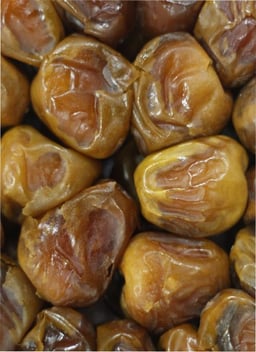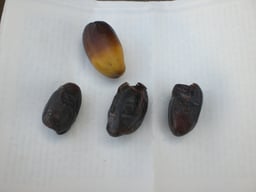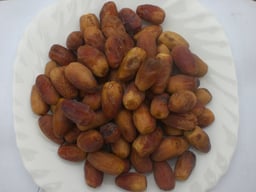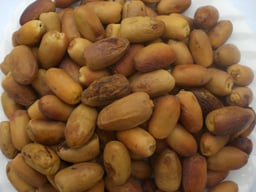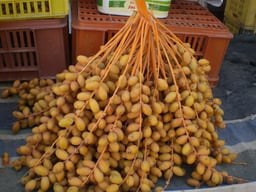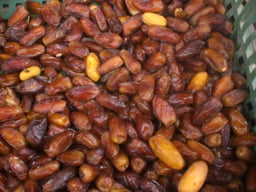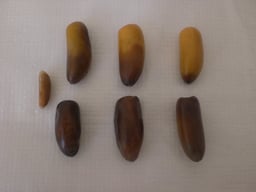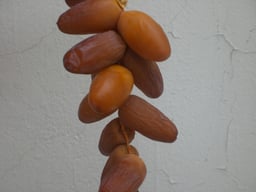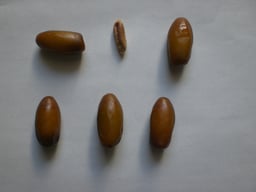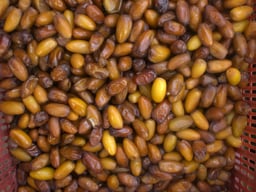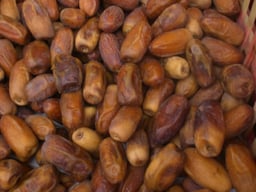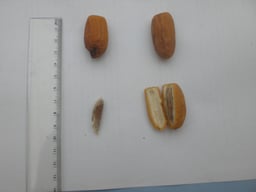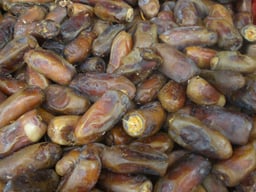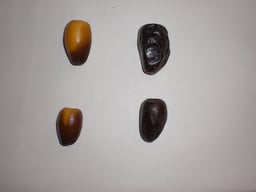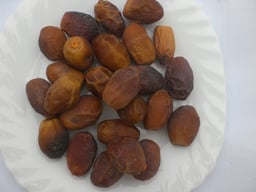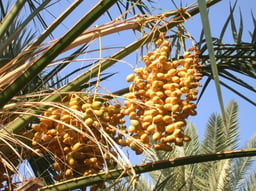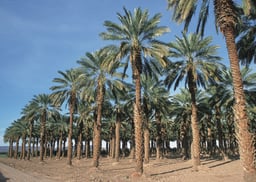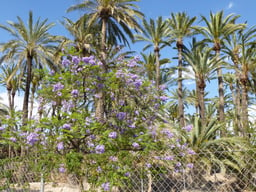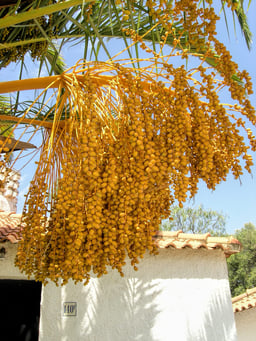Date palm
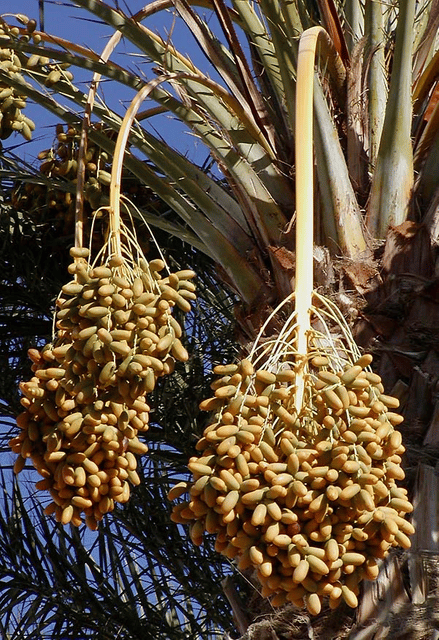
Date palm

| Date palm | |
|---|---|
| Dates on a date palm | |
| Scientific classification | |
| Kingdom: | Plantae |
| Clade: | Angiosperms |
| Clade: | Monocots |
| Clade: | Commelinids |
| Order: | Arecales |
| Family: | Arecaceae |
| Genus: | Phoenix |
| Species: | |
| Binomial name | |
| Phoenix dactylifera | |
| Synonyms[1] | |
| Nutritional value per 100 g (3.5 oz) | |
| Energy | 1,178 kJ (282 kcal) |
| Sugars | 63.35 g (2.235 oz) |
| Dietary fiber | 8 g (0.28 oz) |
| Vitamins | Quantity |
| Vitamin A equiv. | |
| Vitamin A | 10 IU |
| Thiamine (B1) | |
| Riboflavin (B2) | |
| Niacin (B3) | |
| Pantothenic acid (B5) | |
| Vitamin B6 | |
| Folate (B9) | |
| Vitamin C | |
| Vitamin E | |
| Vitamin K | |
| Minerals | Quantity |
| Calcium | |
| Iron | |
| Magnesium | |
| Manganese | |
| Phosphorus | |
| Potassium | |
| Sodium | |
| Zinc | |
| Other constituents | Quantity |
| Water | 20.53 g (0.724 oz) |
| Percentages are roughly approximated usingUS recommendationsfor adults. | |

Palmae Phoenix dactylifera Trunk section. It's not a real tree, so there are no tree rings
Phoenix dactylifera, commonly known as date or date palm,[2] is a flowering plant species in the palm family, Arecaceae, cultivated for its edible sweet fruit. Although its exact place of origin is uncertain because of long cultivation, it probably originated from the Fertile Crescent region straddling between Egypt and Mesopotamia.[3] The species is widely cultivated across Northern Africa, the Middle East, the Horn of Africa and South Asia, and is naturalized in many tropical and subtropical regions worldwide.[4][5][6] P. dactylifera is the type species of genus Phoenix, which contains 12–19 species of wild date palms, and is the major source of commercial production.[3]
Date trees typically reach about 21–23 metres (69–75 ft) in height,[7] growing singly or forming a clump with several stems from a single root system.
Date fruits (dates) are oval-cylindrical, 3 to 7 centimetres (1.2 to 2.8 in) long, and about 2.5 centimetres (0.98 in) in diameter, ranging from bright red to bright yellow in colour, depending on variety.
They are very sweet, containing about 75 percent of sugar when dried.
Dates have been a staple food of the Middle East and the Indus Valley for thousands of years. There is archaeological evidence of date cultivation in Arabia from the 6th millennium BCE. The total annual world production of dates amounts to 8.5 million metric tons, countries of the Middle East and North Africa being the largest producers.[8]
| Date palm | |
|---|---|
| Dates on a date palm | |
| Scientific classification | |
| Kingdom: | Plantae |
| Clade: | Angiosperms |
| Clade: | Monocots |
| Clade: | Commelinids |
| Order: | Arecales |
| Family: | Arecaceae |
| Genus: | Phoenix |
| Species: | |
| Binomial name | |
| Phoenix dactylifera | |
| Synonyms[1] | |
| Nutritional value per 100 g (3.5 oz) | |
| Energy | 1,178 kJ (282 kcal) |
| Sugars | 63.35 g (2.235 oz) |
| Dietary fiber | 8 g (0.28 oz) |
| Vitamins | Quantity |
| Vitamin A equiv. | |
| Vitamin A | 10 IU |
| Thiamine (B1) | |
| Riboflavin (B2) | |
| Niacin (B3) | |
| Pantothenic acid (B5) | |
| Vitamin B6 | |
| Folate (B9) | |
| Vitamin C | |
| Vitamin E | |
| Vitamin K | |
| Minerals | Quantity |
| Calcium | |
| Iron | |
| Magnesium | |
| Manganese | |
| Phosphorus | |
| Potassium | |
| Sodium | |
| Zinc | |
| Other constituents | Quantity |
| Water | 20.53 g (0.724 oz) |
| Percentages are roughly approximated usingUS recommendationsfor adults. | |
Etymology
The species name dactylifera "date-bearing" comes from the Greek words daktylos (δάκτυλος), which means "date" (also "finger"),[9] and fero (φέρω), which means "I bear".[10] The fruit is known as a date.[11] The fruit's English name (through Old French), as well as the Latin both come from the Greek word for "finger", dáktulos, because of the fruit's elongated shape.
History

Dried date, peach, and apricot from Lahun, Fayum, Egypt.
Fossil records show that the date palm has existed for at least 50 million years.[12]
Dates have been a staple food of the Middle East and the Indus Valley for thousands of years. There is archaeological evidence of date cultivation in eastern Arabia between 5530 and 5320 calBC.[13] They are believed to have originated around what is now Iraq, and have been cultivated since ancient times from Mesopotamia to prehistoric Egypt. The Ancient Egyptians used the fruits to make date wine, and ate them at harvest.
There is archaeological evidence of date cultivation in Mehrgarh around 7000 BCE, a Neolithic civilization in what is now western Pakistan. Evidence of cultivation is continually found throughout later civilizations in the Indus Valley, including the Harappan period 2600 to 1900 BCE.[14]
In Ancient Rome the palm fronds used in triumphal processions to symbolize victory were most likely those of Phoenix dactylifera.[15] The date palm was a popular garden plant in Roman peristyle gardens, though it would not bear fruit in the more temperate climate of Italy.[16] It is recognizable in frescoes from Pompeii and elsewhere in Italy, including a garden scene from the House of the Wedding of Alexander.[16]
In later times, traders spread dates around South West Asia, northern Africa, and Spain. Dates were introduced into Mexico and California by the Spaniards in 1765, around Mission San Ignacio.
A genomic study from New York University Abu Dhabi Center for Genomics and Systems Biology showed that domesticated date palm varieties from North Africa, including well-known varieties such as Medjool and Deglet Nour, are a hybrid between Middle East date palms and the Cretan wild palm P. theophrasti. Date palms appear in the archaeological record in North Africa about 2,800 years ago, suggesting that the hybrid was spread by the Minoans or Phoenicians.[20]
Description

Date fruit clumps
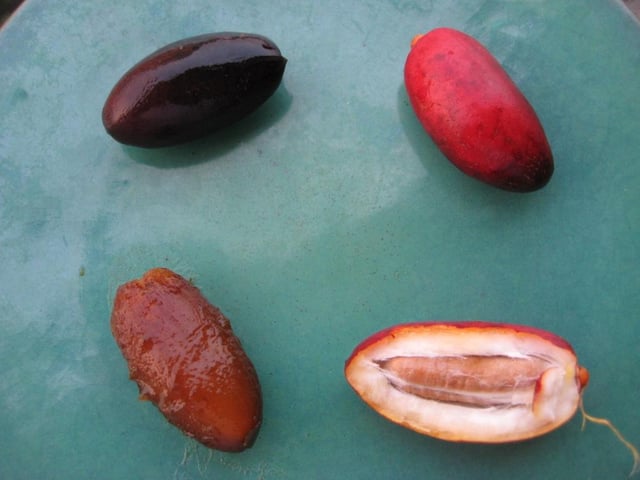
Fresh dates, clockwise from top right: crunchy, crunchy opened, soft out of skin, soft
Date trees typically reach about 21–23 metres (69–75 ft) in height,[7] growing singly or forming a clump with several stems from a single root system.
The leaves are 4–6 metres (13–20 ft) long, with spines on the petiole, and pinnate, with about 150 leaflets. The leaflets are 30 cm (12 in) long and 2 cm (0.79 in) wide. The full span of the crown ranges from 6–10 m (20–33 ft).
The date palm is dioecious, having separate male and female plants. They can be easily grown from seed, but only 50% of seedlings will be female and hence fruit bearing, and dates from seedling plants are often smaller and of poorer quality. Most commercial plantations thus use cuttings of heavily cropping cultivars. Plants grown from cuttings will fruit 2–3 years earlier than seedling plants.
Dates are naturally wind pollinated, but in both traditional oasis horticulture and in the modern commercial orchards they are entirely pollinated manually. Natural pollination occurs with about an equal number of male and female plants. However, with assistance, one male can pollinate up to 100 females. Since the males are of value only as pollinators, this allows the growers to use their resources for many more fruit-producing female plants. Some growers do not even maintain any male plants, as male flowers become available at local markets at pollination time. Manual pollination is done by skilled labourers on ladders, or by use of a wind machine. In some areas such as Iraq the pollinator climbs the tree using a special climbing tool that wraps around the tree trunk and the climber's back (called تبلية in Arabic) to keep him attached to the trunk while climbing.
Date fruits are oval-cylindrical, 3–7 cm (1.2–2.8 in) long, and 2–3 cm (0.79–1.18 in) diameter, and when ripe, range from bright red to bright yellow in colour, depending on variety.
Dates contain a single stone about 2–2.5 cm (0.8–1.0 in) long and 6–8 mm (0.2–0.3 in) thick. Three main cultivar groups of date exist: soft (e.g. 'Barhee', 'Halawy', 'Khadrawy', 'Medjool'); semi-dry (e.g. 'Dayri', 'Deglet Nour', 'Zahdi'), and dry (e.g. 'Thoory'). The type of fruit depends on the glucose, fructose, and sucrose content.
Genome
Cultivation
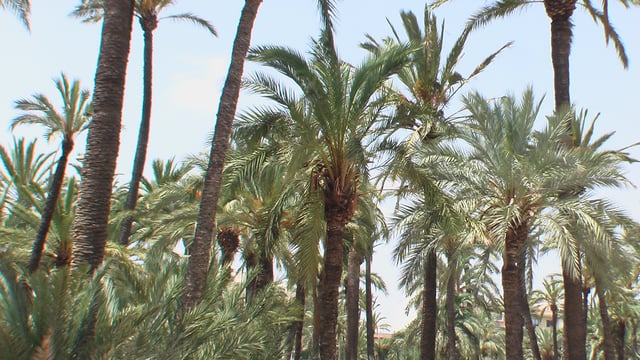
The Palmeral de Elche (Southern Spain) is the biggest palm tree forest in Europe, declared a World Heritage Site by the Unesco.

Germination of date palm
Date palms can take 4 to 8 years after planting before they will bear fruit, and start producing viable yields for commercial harvest between 7 and 10 years.
Mature date palms can produce 150–300 lb (70–140 kg)[23][24] of dates per harvest season. They do not all ripen at the same time so several harvests are required. To obtain fruit of marketable quality, the bunches of dates must be thinned and bagged or covered before ripening so that the remaining fruits grow larger and are protected from weather and animals that also live off of it, such as birds.
Date palms require well-drained deep sandy loam soils with pH 8-11.
The soil should have the ability to hold the moisture.
The soil should also be free from calcium carbonate.[25]
Production
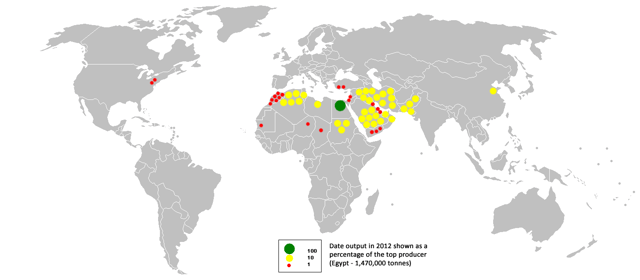
Date production per country in 2012
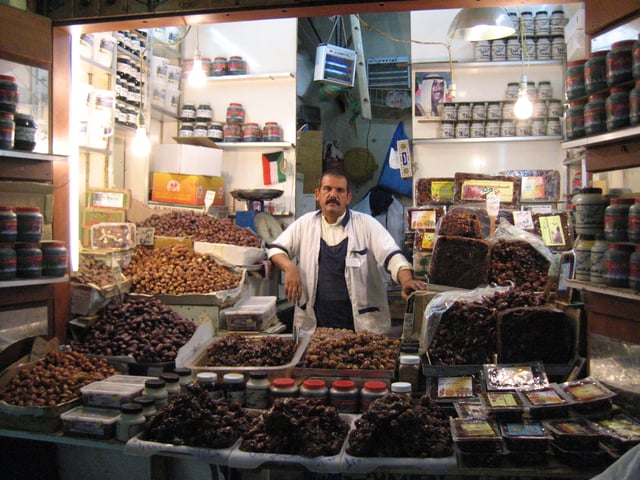
Date seller in the old souq in Kuwait City
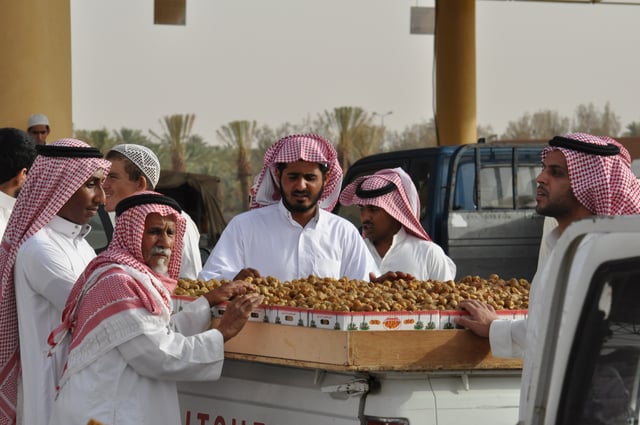
Date City in Buraidah
| Top ten date producers – 2017(tonnes) | ||
|---|---|---|
| *Source:UN Food and Agriculture Organization(FAO)*[8] | ||
Cultivars
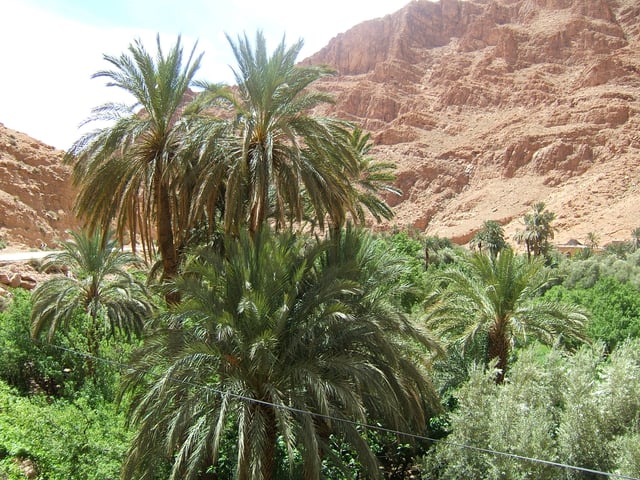
Date palm orchard, Boumalne, Morocco
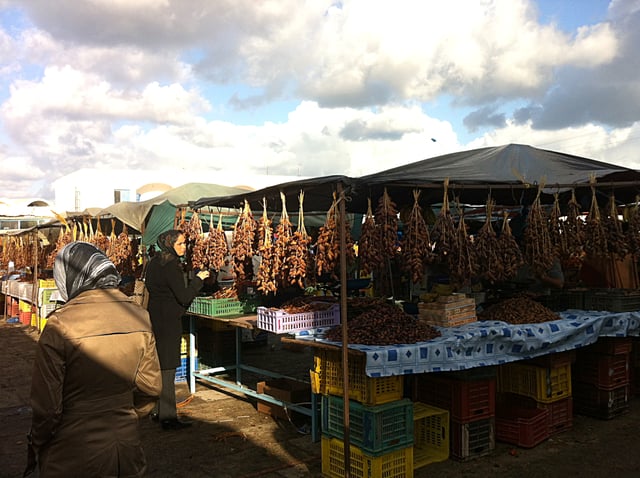
Dates in the souq in Sayada
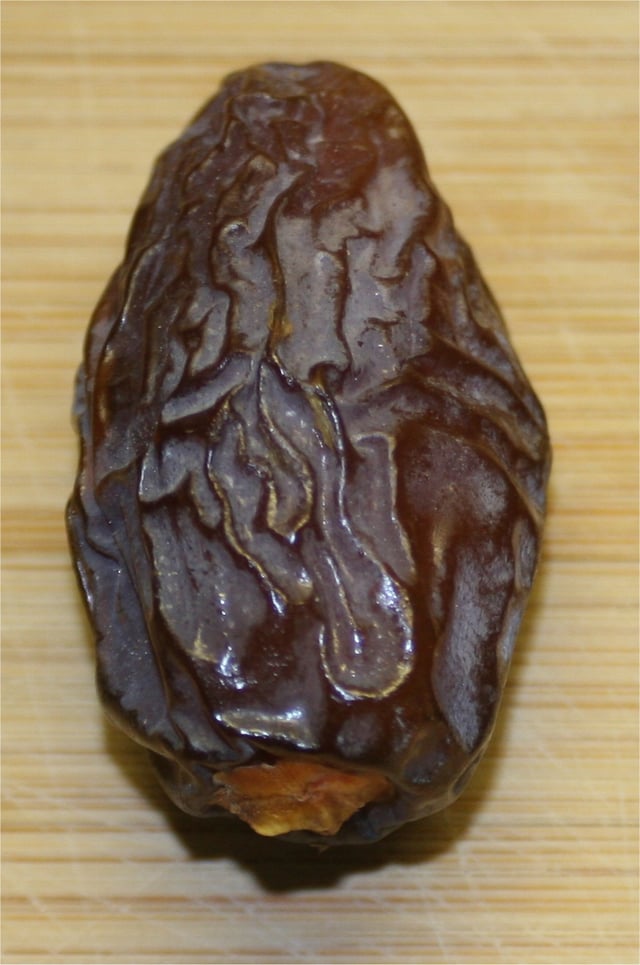
Medjool date
A large number of date cultivars are grown.
The most important are:
Aabel – common in Libya.
Ajwah – from the town of Medina in Saudi Arabia, it is the subject of a Hadith.
Al-Khunaizi – from the town of Qatif in Saudi Arabia.
Amir Hajj or Amer Hajj – from Iraq, these are soft with a thin skin and thick flesh, sometimes called "the visitor's date" because it is a delicacy served to guests.
ʿAbid Rahim*]]Arabic: عبد رحيم) – from Sudan. In Nigeria it is calledDabino*.
Barakawi (Arabic: بركاوي) – from Sudan.
Barhee or barhi (from Arabic barh, meaning 'a hot wind') – these are nearly spherical, light amber to dark brown when ripe; soft, with thick flesh and rich flavour. One of the few varieties that are good in the khalal stage when they are yellow (like a fresh grape, as opposed to dry, like a raisin).
Bireir (Arabic: برير) – from Sudan.
Dabbas – from United Arab Emirates.
Datça – in Turkey
Deglet Noor
Derrie or Dayri (the "Monastery" date) – from southern Iraq – these are long, slender, nearly black, and soft.
Empress – developed by the DaVall family in Indio, California, United States, from a seedling of Thoory. It is large, and is softer and sweeter than Thoory. It generally has a light tan top half and brown bottom half.
Fardh or Fard – common in Oman, deep dark brown, tender skin, sweet flavor, small seed. Keeps well when well packed.
Ftimi or Alligue – these are grown in inland oases of Tunisia.
Holwah (Halawi) (Arabic for sweet) – these are soft, and extremely sweet, small to medium in size.
Haleema – in Hoon, Libya (Haleema is a woman's name).
Hayany (Hayani) – from Egypt ("Hayany" is a man's name) – these dates are dark-red to nearly black and soft.
Iteema – common in Algeria.
Kenta – common in Tunisia.
Khadrawi or Khadrawy (Arabic: 'green') – a cultivar favoured by many Arabs, it is a soft, very dark date.
Khalasah (Arabic for quintessence) – one of the major palm cultivars in Saudi Arabia. Its fruit is called Khlas. Notably produced in Hofuf (Al-Ahsa) and Qatif in the Eastern Province of Saudi Arabia (ash-Sharqīyah).
Khastawi (Khusatawi, Kustawy) – this is the leading soft date in Iraq; it is syrupy and small in size, prized for dessert.
Khenaizi – from United Arab Emirates.
Lulu – from United Arab Emirates.
Maktoom (Arabic for hidden) – this is a large, red-brown, thick-skinned, soft, medium-sweet date.
Manakbir – a large fruit that ripens early.
Medjool or (Majdool) (Arabic: مجدول) – from Morocco, also grown in the United States, Israel, Saudi Arabia, South Africa, Jordan, and United Arab Emirates; a large, sweet and succulent date.[12]
Migraf (Mejraf) – very popular in Southern Yemen, these are large, golden-amber dates.
Mgmaget Ayuob – from Hun, Libya.
Mishriq (Arabic: مشرق "east") – from Sudan and Saudi Arabia.
Mazafati or Mozafati – (Persian: مضافتی, "Suburban/Peripheral") It is a dark, fleshy and sweet date of medium size with a relatively high moisture content and is suited for fresh consumption, i.e. not dried. At a temperature of −5 degrees Celsius (23 °F) it can be kept for up to 2 years. It is grown in Iran, in particular in Kerman province, and often named "Bam date", after the city of Bam in that province.[26]
Nabtat-seyf – in Saudi Arabia.
Rotab (Arabic: رطب) – from Iraq, they are dark and soft.
Sag‘ai – from Saudi Arabia.
Saidy (Saidi) – soft, very sweet, these are popular in Libya.
Sayer (Sayir) (Arabic for common) – these dates are dark orange-brown, of medium size, soft and syrupy.
Sukkary – (Arabic: سكري, "Sugar" or "Sweet one") Yellow skinned; faintly resilient and extremely sweet, often referred to as ‘royal dates’. It's cultivated primarily in Al Qassim, Saudi Arabia. It's arguably the most expensive and premium variety.[28]
Sellaj – (Arabic: سلّج) in Saudi Arabia.
Sinhala: ඉඳ) called in Sri Lanka.
Tagyat – common in Libya.
Tamej – in Libya.
Thoory (Thuri) – popular in Algeria, this dry date is brown-red when cured with a bluish bloom and very wrinkled skin. Its flesh is sometimes hard and brittle but the flavour described as sweet and nutty.
Umeljwary – in Libya.
Umelkhashab – Brilliant red skin; bittersweet, hard white flesh (Saudi Arabia).
Zahidi (Arabic for [Of the] ascetic) – these medium size, cylindrical, light golden-brown semi-dry dates are very sugary, and sold as soft, medium-hard and hard.
Zaghloul (Arabic: زغلول) – Dark red skin, long, and very crunchy when fresh (when they are typically served); extremely sweet, with sugar content creating a sense of desiccation in the mouth when eaten. The variety is essentially exclusive to Egypt, where it is subject to an element of nationalist sentiment on account of sharing a name with national hero Saad Zaghloul.
The Gaza Strip, especially Deir al-Balah ("Village of Dates"), is known for its exceptionally sweet red dates.
| English | Arabic | English | Arabic | English | Arabic | English | Arabic |
|---|---|---|---|---|---|---|---|
| Afandi | أفندي | Jebaily | جبيلي | Medjoul | مدجول | Sawaida | سويدا |
| Ajwah | عجوة | Ka'ikah | كعيكه | Menaify | منيفي | Shahel | شهل |
| Anbarah | عنبرة | Khalas | خلاص | Meskany | مسكاني | Shalaaby | شلابي |
| Baiḍ | بيض | Khudry | خضري | Mushukah | مشوكة | Shuqry | شقري |
| Barny | برني | Khuḍab | خصاب | Rabiyyah | ربيعة | Sufry | صفري |
| Berḥi | برحي | Lunah | لونة | Rashudiah | رشوديه | Sukkary | سكري |
| Gharr | غر | Lubanah | لبانة | Safaawy | صفاوي | Suqa'ey | صقعي |
| Ḥelwah | حلوة | Mabrum | مبروم | Sheeshee | شيشي | Wananah | ونانة |
| Ḥilya | حلية | Maktoomi | مكتومي | Sariyyah | سارية | Dhawy | ذاوي |
| Khunayzey | خنيزي | Um Ruhaim | ام رحيم | Hilali | هلالي | Nabtat Sultan | نبتة سلطان |
Diseases and pests
A major palm pest, the red palm beetle (Rhynchophorus ferrugineus
In the 1920s, eleven healthy Madjool palms were transferred from Morocco to the United States where they were tended by members of the Chemehuevi tribe in a remote region of Nevada. Nine of these survived and in 1935, cultivars were transferred to the "U.S. Date Garden" in Indio, California. Eventually this stock was reintroduced to Africa and led to the U.S. production of dates in Yuma, Arizona, and the Bard Valley in California.[29]
Uses
Fruits
Dry or soft dates are eaten out-of-hand, or may be pitted and stuffed with fillings such as almonds, walnuts, pecans, candied orange and lemon peel, tahini, marzipan or cream cheese. Pitted dates are also referred to as stoned dates. Partially dried pitted dates may be glazed with glucose syrup for use as a snack food. Dates can also be chopped and used in a range of sweet and savory dishes, from tajines (tagines) in Morocco to puddings, ka'ak (types of Arab cookies) and other dessert items. Date nut bread, a type of cake, is very popular in the United States, especially around holidays. Dates are also processed into cubes, paste called 'ajwa, spread, date syrup or "honey" called "dibs" or rub in Libya, powder (date sugar), vinegar or alcohol. Vinegar made from dates is a traditional product of the Middle East.[30][31] Recent innovations include chocolate-covered dates and products such as sparkling date juice, used in some Islamic countries as a non-alcoholic version of champagne, for special occasions and religious times such as Ramadan. When Muslims break fast in the evening meal of Ramadan, it is traditional to eat a date first.
Reflecting the maritime trading heritage of Britain, imported chopped dates are added to, or form the main basis of a variety of traditional dessert recipes including sticky toffee pudding, Christmas pudding and date and walnut loaf. They are particularly available to eat whole at Christmas time. Dates are one of the ingredients of HP Sauce, a popular British condiment.
Dates can also be dehydrated, ground and mixed with grain to form a nutritious stockfeed.
In Southeast Spain (where a large date plantation exists including UNESCO-protected Palmeral of Elche) dates (usually pitted with fried almond) are served wrapped in bacon and shallow fried, served with ranch dressing.
In Israel date syrup, termed silan, is used while cooking chicken and also for sweet and desserts, and as a honey substitute.
Dates are one of the ingredients of jallab
In Pakistan, a viscous, thick syrup made from the ripe fruits is used as a coating for leather bags and pipes to prevent leaking.
Nutritional value
Dates provide a wide range of essential nutrients, and are a very good source of dietary potassium. The sugar content of ripe dates is about 80%; the remainder consists of protein, fiber, and trace elements including boron, cobalt, copper, fluorine, magnesium, manganese, selenium, and zinc.[32] The glycemic index for three different varieties of dates are 35.5 (khalas), 49.7 (barhi), and 30.5 (bo ma'an).[33]
Other parts
Seeds
Date seeds are soaked and ground up for animal feed. Their oil is suitable for use in soap and cosmetics. Date palm seeds contain 0.56–5.4% lauric acid. They can also be processed chemically as a source of oxalic acid. Date seeds are also ground and used in the manner of coffee beans, or as an additive to coffee. Experimental studies have shown that feeding mice with the aqueous extract of date pits exhibit anti-genotoxic and reduce DNA damage induced by N-nitroso-N-methylurea.[35]
Fruit clusters
Stripped fruit clusters are used as brooms.
Recently the floral stalks have been found to be of ornamental value in households.[36]
Sap
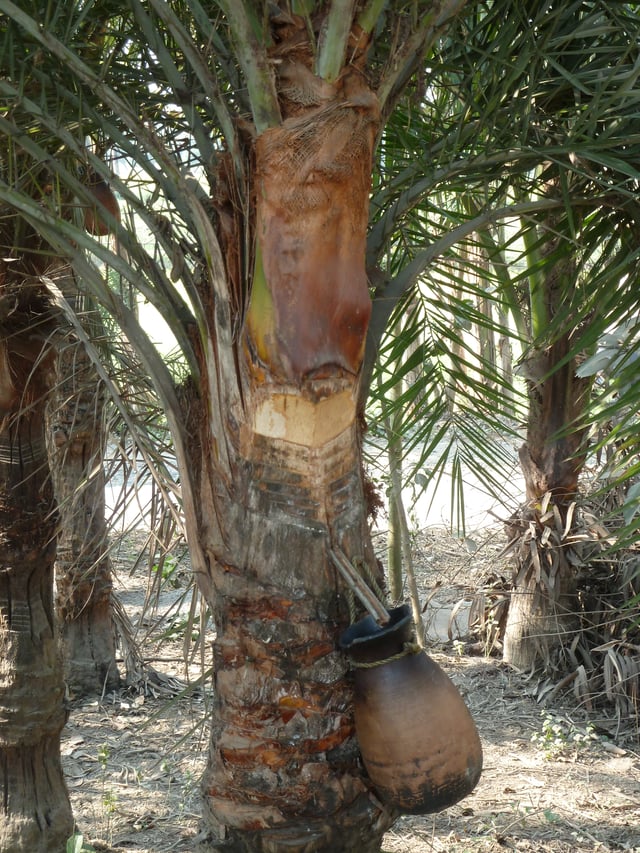
Sweet sap tapped from date palm in West Bengal, India
Apart from P. dactylifera, wild date palms such as Phoenix sylvestris and Phoenix reclinata
Leaves
Date palm leaves are used for Palm Sunday in the Christian religion. In North Africa, they are commonly used for making huts. Mature leaves are also made into mats, screens, baskets and fans. Processed leaves can be used for insulating board. Dried leaf petioles are a source of cellulose pulp, used for walking sticks, brooms, fishing floats and fuel. Leaf sheaths are prized for their scent, and fibre from them is also used for rope, coarse cloth, and large hats. The leaves are also used as a lulav in the Jewish holiday of Sukkot.
Young date leaves are cooked and eaten as a vegetable, as is the terminal bud or heart, though its removal kills the palm.
The finely ground seeds are mixed with flour to make bread in times of scarcity. The flowers of the date palm are also edible. Traditionally the female flowers are the most available for sale and weigh 300–400 grams (11–14 oz). The flower buds are used in salad or ground with dried fish to make a condiment for bread.
Culture

Date Palm in the Coat of arms of Saudi Arabia
Dates are mentioned more than 50 times in the Bible and 20 times in the Qur'an.
Many Jewish scholars believe that the "honey" reference in the Bible to "a land flowing with milk and honey" (Exodus chapter 3) is actually a reference to date "honey", and not honey from bees.[37]
In Islamic culture, dates and yogurt or milk are traditionally the first foods consumed for Iftar after the sun has set during Ramadan.
The date palm represents the provincial tree of Balochistan (Pakistan) (unofficial).
Symbolism
Phoenix dactylifera held great significance in early Judaism and subsequently in Christianity, in part because the tree was heavily cultivated as a food source in ancient Israel.[40] In the Bible palm trees are referenced as symbols of prosperity and triumph.[41] In Psalm 92:12 "The righteous shall flourish like the palm tree".
Palm branches occurred as iconography in sculpture ornamenting the Second Jewish Temple in Jerusalem, on Jewish coins, and in the sculpture of synagogues. They are also used as ornamentation in the Feast of the Tabernacles.[40] Palm branches were scattered before Jesus as he entered Jerusalem on Palm Sunday.
